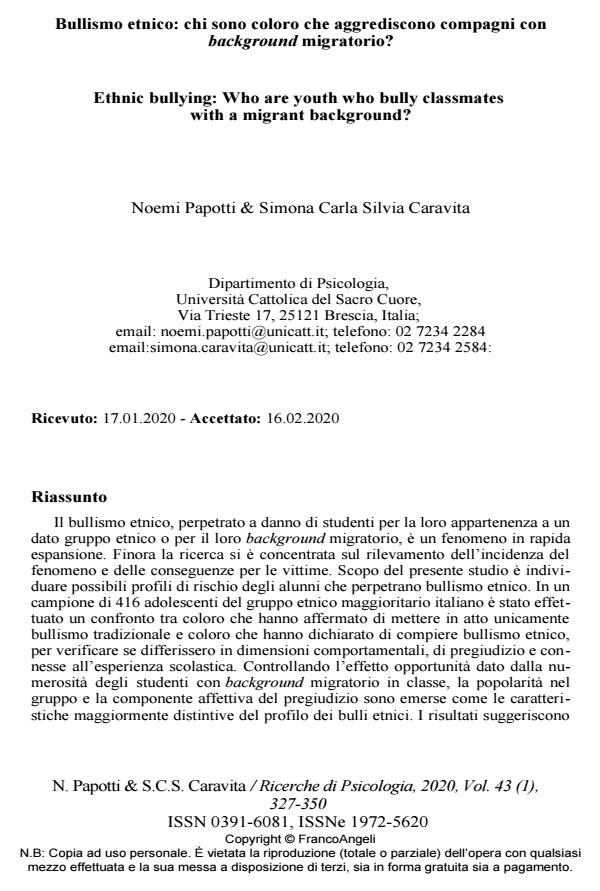Ethnic bullying: Who are youth who bully classm with a migrant background?
Journal title RICERCHE DI PSICOLOGIA
Author/s Noemi Papotti , Simona Carla Silvia Caravita
Publishing Year 2020 Issue 2020/1
Language Italian Pages 24 P. 327-350 File size 248 KB
DOI 10.3280/RIP2020-001015
DOI is like a bar code for intellectual property: to have more infomation
click here
Below, you can see the article first page
If you want to buy this article in PDF format, you can do it, following the instructions to buy download credits

FrancoAngeli is member of Publishers International Linking Association, Inc (PILA), a not-for-profit association which run the CrossRef service enabling links to and from online scholarly content.
Ethnic bullying, perpetrated against students because of belonging to a particular ethnic group or their migratory background, is a rapidly expanding phenomenon. So far, research has focused on investigating the incidence of the phenomenon and the consequences for the victims. Aim of this study is to identify the possible risk profiles of pupils who perpetrate ethnic bullying. In a sample of 416 adolescents of the majority Italian ethnic group, a comparison was made between those who claimed to perpetrate only traditional bullying and those who claimed to perpetrate ethnic bullying, to check if they differed in prejudice and behavioral dimensions, and dimensions related to their school experience. When the opportunity effect, due to the percentage of students with migrant backgrounds in the classroom, was controlled for, peer popularity and the emotional component of prejudice emerged as the most distinctive characteristics of the profile of ethnic bullies. Results suggest that traditional anti-bullying programs, which focus primarily on group dynamics, are not enough to prevent and to tackle ethnic bullying.
Keywords: Ethnic bullying, immigration, prejudice, peer relationships, social skills.
- The Strengths and Difficulties Questionnaire Dysregulation Profile Teacher-Report: Psychometric Properties and Associations with Aspects of School Experience Valentina Levantini, Marina Camodeca, Carmen Gelati, in Child Psychiatry & Human Development /2024 pp.831
DOI: 10.1007/s10578-022-01441-5 - Negative attitudes towards ethnic minorities and ethnic bullying and discrimination: a systematic review and meta-analysis Maria Chiara Taiti, Benedetta E. Palladino, Maria Grazia Lo Cricchio, Fulvio Tassi, Ersilia Menesini, in European Journal of Developmental Psychology /2024 pp.795
DOI: 10.1080/17405629.2024.2371547 - Migrazioni e psicologie. Introduzione al Forum Alessandro Antonietti, Antonella Marchetti, in RICERCHE DI PSICOLOGIA 1/2020 pp.13
DOI: 10.3280/RIP2020-001002 - Prejudice and Ethnic Bullying Among Children: The Role of Moral Disengagement and Student-Teacher Relationship Nicolò Maria Iannello, Marina Camodeca, Carmen Gelati, Noemi Papotti, in Frontiers in Psychology 713081/2021
DOI: 10.3389/fpsyg.2021.713081 - Prestige norms of moral disengagement, prejudice, and ethnic bullying: a study among Italian early adolescents Noemi Papotti, Simona C. S. Caravita, in European Journal of Developmental Psychology /2024 pp.627
DOI: 10.1080/17405629.2023.2275824
Noemi Papotti , Simona Carla Silvia Caravita, Bullismo etnico: chi sono coloro che aggrediscono compagni con background migratorio? in "RICERCHE DI PSICOLOGIA " 1/2020, pp 327-350, DOI: 10.3280/RIP2020-001015